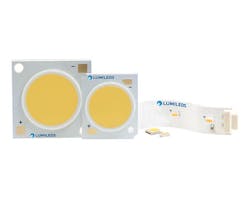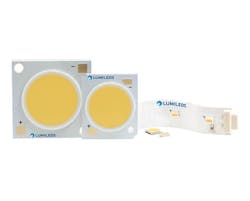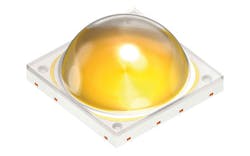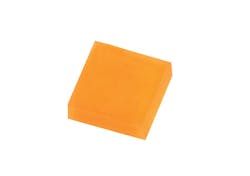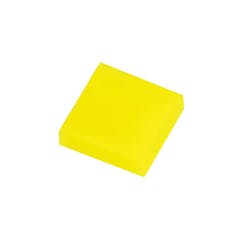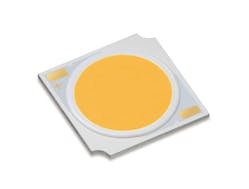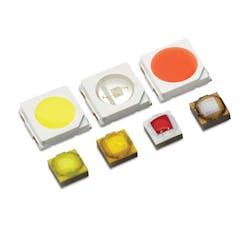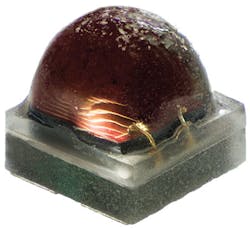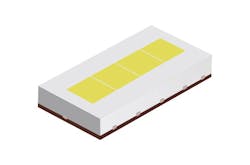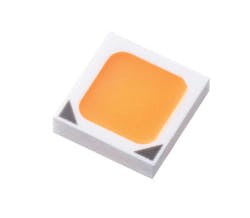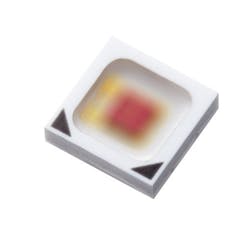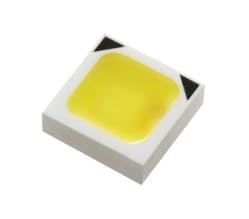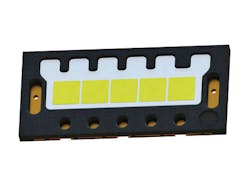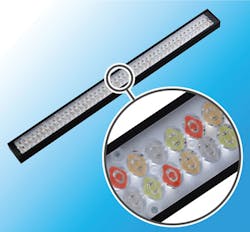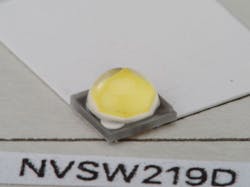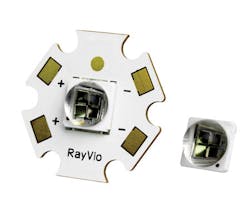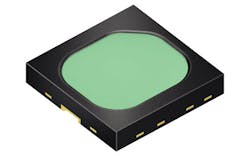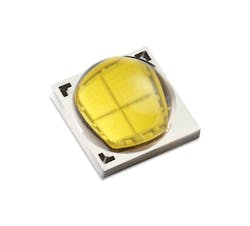Over the course of 2016 and early 2017, the packaged LED industry has continued the march to specialization while also pushing to all new levels of light/power output and efficacy. Indeed, watching the technology parade is barely short of amazing as technical barriers to the usage of solid-state lighting (SSL) fall in applications as mundane as retail lighting and as obscure as ultraviolet (UV) sterilization. Still, it's advancements in light quality and spectral power distribution (SPD) that are most exciting when it comes to general lighting applications and even specialty uses such as in horticultural lighting or lighting for health and wellbeing. In this roundup of some of the most exciting packaged LED announcements made in roughly the past year, we will describe emerging technical features and architectural advancements and explore the myriad of emerging applications for SSL. - MAURY WRIGHT
Lumileds Stylist Series of COB LEDs
Over the course of mid-summer into the fall of 2016, Lumileds rolled out numerous members of what the company has called the Stylist portfolio of chip-on-board (COB) LEDs with SPDs tuned to a new level of specialization for applications. For example, the FreshFocus components in the portfolio target grocery-market applications and include five different SPDs intended for enhancing the look and appeal of produce, fish, marbled meat (red meat with prevalent white fat), red meat, and bread and pastries. The CrispColor line similarly targets retail while the AtmoSphere line targets restaurant and hospitality applications. What's clear about CrispColor and the other new lines in the Stylist Series is that Lumileds' engineers focused far beyond CCT in developing the new LEDs. Indeed, the SPD has been optimized in each case based on research into customer preference. In the CrispColor line, Lumileds offers a range of CCTs from 2700K to 5000K. In each CCT, however, the SPD delivers light well below the black body locus (BBL), indeed even further from the BBL than the CrispWhite products fall - CrispWhite was really the precursor to Stylist launched a few years back. That decision was based on studies that reveal human preference. The AtmoSphere line, conversely, falls directly on the BBL at a CCT of 2200K. Many restaurants achieve that type of lighting SPD using dimmed halogen lamps today. The FreshFocus, AtmoSphere, CrispColor, and CrispWhite lines will be offered across the Lumileds portfolio of COB light-emitting surface (LES) sizes from 6-23 mm. We remain interested to see how much SPD granularity is just right and how much might be too much for luminaire makers and lighting customers to handle.
Cree XHP50.2 COB LEDs
In parallel with light quality developments, LED manufacturers across the board are pushing output power (lumens in LEDs that target general lighting for humans and radiant power in other applications), and efficacy in lm/W or some other efficiency measure. Cree has remained at the forefront in maximizing lumen output and efficacy and the second generation of the Extreme High Power (XHP) product portfolio that debuted right at the end of 2016 offers a good example. The XHP50.2 LEDs (also a new product labeling scheme for Cree) measure 5×5 mm and include four emitters in a discrete-style LED package. The new LEDs delivered a 7% boost in lumen output and 10% efficacy improvement relative to the original XHP50 products announced two years back when Cree rolled out its SC5 (Silicon Carbide 5) technology platform. Cree also has the XHP70 LEDs in a 7×7-mm form factor and the XHP35 in a 3.5×3.5-mm form factor. Cree of course has pushed performance across its entire XLamp high-power LED portfolio.
Osram Opto Semiconductors Duris P 10 LEDs
The cost of LED components of course remains an issue in the uptake of SSL for general illumination, although as we reported after Strategies in Light last year there has been considerable price erosion in LED components. While LED prices impact the bill of materials in a lamp or luminaire to a lesser degree than in the past, component price will always be an issue. Indeed, cost concerns have driven the mid-power LED revolution that we have chronicled over the course of the past five years. Osram Opto Semiconductors has been at the forefront of bridging the chasm between mid- and high-power LEDs and bringing some of the low-cost angles of mid-power architectures to the high-power sector. Indeed, in our packaged LED feature last year we covered the Osram Duris S 5 that has mid-power looks but is intended as a COB LED alternative. In 2016, Osram introduced the Duris P 10 that looks like the typical high-power LED in a discrete package but uses architectural features found in mid-power devices, and indeed Duris is an Osram brand that's synonymous with mid-power LEDs. Specifically, the LEDs are built on a cost-effective lead frame architecture and epoxy is used in the package. Yet the LEDs have the light output and thermal stability needed for demanding applications such as street lights. The LED family delivers a maximum of 1100 lm and Osram said the development relied on experience it gained developing cost-effective LEDs for automotive applications where the environment is harsh, cost is an issue, and performance is a requisite.
Seoul Semiconductor WICOP LED family
Chip-scale package (CSP) LEDs continue to loom as the next evolution in packaged LEDs, although as we have pointed out before, the concept is the lack of a package so the terminology is confusing in general. Still, the minimal packaging can potentially offer further cost savings at the expense of more complicated lamp and luminaire manufacturing as we have previously chronicled. We noted last year that Seoul Semiconductor has moved near the lead in terms of LED manufacturers offering CSP LEDs for general lighting, and Seoul refers to its technology as WICOP (wafer-level integrated chip on PCB). The company has continued to evolve the WICOP offering with four LED footprints - the Z8Y22 measures 2.21×2.21 mm, the Z8Y19 measures 1.81×1.81 mm, the Z8Y15 measures 1.41×1.41 mm, and the Z8Y11 measures 1.14×1.14 mm. In terms of footprint and lumen output, the LEDs scale across applications that have been served by both mid- and high-power discrete LEDs. Seoul's progress has gone far beyond datasheets. The company now has LM-80 data across the product line indicating 6000 hours or more of detailed characterization of LED performance. LM-80 data is critical to usage of the LEDs in general lighting applications. Moreover, the company said there is one street light on the market using the CSP components. That design illustrates the ability to closely pack CSP components on a printed circuit board (PCB). Four LEDs are clustered under a single total internal reflection (TIR) lens in the design.
Citizen Vivid Series of COB LEDs
Back to enhancing colors and whites in objects, Citizen Electronics announced the CITILED Vivid Series with two lines of products, each consisting of 25 different components. The Vivid Brilliant COB LEDs are intended to oversaturate colors, making objects appear more vivid. The Vivid Natural LEDs are intended to deliver a more vivid appearance while maintaining what Citizen calls a natural look. The former products are intended to directly illuminate displays such as in retail applications while the latter are intended more for ambient lighting and both can be combined in a space. Citizen has turned to the CIE (International Commission on Illumination) 1976 color space to define the capabilities of the LEDs. That specification includes the notion of chroma levels for 16 color samples. Compared to the company's prior Vivid Series LEDs, the Vivid Brilliant LEDs have elevated green and red chroma levels. The Vivid Natural LEDs, meanwhile, seek to more evenly balance the chroma levels across the spectrum. Citizen also attempts to distinguish its COB products from the competition, calling them chip-on-aluminum components. Presumably, the substrate offers thermal advantages for luminaire developers.
Lumileds SunPlus LED family
We mentioned horticultural lighting as a burgeoning application in the introduction of this article, and that application affords a great example of specialization within the packaged LED space. If you are unfamiliar with the application, you might peruse a recent feature article on the topic. Plants need different types of light than do humans and indeed metrics such as efficacy don't always apply in evaluating a light source for performance in horticultural applications. Lumileds was clearly armed with significant knowledge about horticultural science when it developed the SunPlus family in the fall of 2016. The portfolio includes all of the colors of LEDs needed in such applications. Moreover, it includes both high- and mid-power LEDs so luminaire makers have the tools to develop relatively-lower-power linear fixtures for vertical farms or for inter-lighting crops such as tomatoes, or relatively-higher-power luminaires for top lighting of traditional greenhouse crops. Lumileds also employed a unique technique in some of the LEDs that are based on phosphor conversion. There are three purple LEDs in the portfolio that have a varied amount of red phosphor combined with a blue pump to deliver the red and blue energy that is known to optimize photosynthesis. To stay abreast of developments in the horticultural lighting application, watch our horticultural microsite companion to our website (ledsmagazine.com/horticulture) and consider attending one of our Horticultural Lighting Conferences (horticulturelightingconference.com).
Cree Photo Red horticultural LEDs
Cree also expanded its presence in the horticultural space in 2016. The company has a number of LEDs in its portfolio that it calls Photo Red. The Photo Red products emit at 660 nm, or what is commonly called the far-red spectrum. That far-red area offers benefits in horticultural applications beyond what you get from more typical 625-nm red LEDs. The Photo Red LED enables luminaire makers to boost the photosynthetic photon flux (PPF) of their products. In the summer of 2016, Cree added a Photo Red LED in the XLamp XQ-E line that comes in a compact 1.6×1.6-mm package. That small footprint is a good match for linear lighting in vertical farms or for inter-lighting. Later in the year, Cree boosted performance across the Photo Red product line. The company said it boosted PPF performance by 21% across the portfolio including in the 3.45×3.45-mm XP-E family. Those larger LEDs target luminaire applications for replacement of the HID lamps that have traditionally been used in greenhouses. The LEDs are being used by luminaire makers such as Spectrum King (covered in the horticultural feature article mentioned earlier). Moreover, we have covered modular light engines from Adura that use the LEDs and that enable luminaire makers to quickly get products to market.
Samsung CSP LEDs for automotive applications
Swapping applications yet again, let's discuss automotive applications - an application that has a significant future in terms of growth as the aforementioned Strategies in Light 2016 article documents. Moreover, automotive was one of the early markets in which CSP LEDs were utilized given the fact that the LEDs are typically sold in modular form, and the automotive upstream supply chain can easily handle the assembly complexity associated with CSP LEDs. Samsung was an early supplier of such LEDs into the automotive application and in mid-2016 announced the Fx-CSP product line that, among other things, shows the benefits of closely-packed CSP LEDs. The Samsung products integrate as many as 12 emitters in a modular package including 1×4 and 2×6 arrays. The 2×6-emitter modules can enable a multi-beam headlamp with one module. Meanwhile, Samsung is also supplying single-emitter components for applications such as daytime running lights (DRLs).
Everlight Electronics 3030CLU automotive LEDs
Everlight Electronics, meanwhile, is servicing the automotive segment with what appear to be mid-power LEDs, but in fact operate at high-power levels and are housed in a ceramic package. The 3×3-mm 3030CLU offering does not include products for headlamps, but does support DRLs, turn indicators, and brake lights. The LEDs deliver a 120° beam pattern through a highly-reflective surface that optimizes light extraction. Everlight has turned to a phosphor-conversion approach for the amber LEDs in the portfolio to boost efficacy and lifetime. And it offers unique features in red. In addition to 612-624-nm red that's considered standard, the product family includes a 627-639-nm super-red that is presumably easier for preceding drivers to see, and that is especially in demand in Europe.
Osram Black Flat S for headlamps
Of course, the ultimate goal in automotive headlamps these days is generically called adaptive drive beam (ADB) headlamps. Such products use sensors including cameras to dynamically track other vehicles, pedestrians, and the direction of the road, and selectively control the headlamp beam to avoid glare to oncoming eyes while providing better visibility for the driver. The technology was pioneered by Audi in 2013 for use in a high-end sedan sold in Europe. Osram, meanwhile, is moving to bring such technologies to mainstream vehicles, and the five-emitter Oslon Black Flat S is one LED that could enable such designs. In the newest members of the Black Flat portfolio, the company has for the first time enabled individual control of each emitter in the array. And the company even has an R&D project in which a headlamp module has 1024 individually-controllable emitters. For more on ADB technology and standards, check the feature article from our February issue.
LED Engin LZ7 for dynamic color lighting
Now let's switch gears and discuss LEDs for dynamic color-tunable lighting including RGB (red, green, blue) systems and even designs with more color channels. Such designs can include lighting in high-profile applications such as façades, or even serve to deliver more flexible human-centric lighting (HCL) or lighting for health and wellbeing. LED Engin takes the approach to the extremes in what looks to be a discrete packaged LED, albeit a large one. The LZ7-04MU00 announced in mid-2016 includes RGBW (RGB plus white) capabilities that are common in color applications, and adds cyan, violet, and amber emitters. The seven-channel LED enables accurate production of even more colors. The LED with a 7×7-mm footprint has a 3.8×3.8-mm LES.
Kyocera violet-emitter LEDs and phosphor
Another company that debuted LED technology and a major façade lighting project in Kyoto, Japan during 2016 is Kyocera. It's unclear whether Kyocera itself plans to manufacture such LEDs, but we choose to mention the development because of the architecture of the LEDs. Like Soraa, Kyocera has used LEDs based on a violet emitter. The company touted that design choice as one element in producing more vibrant colors. And various RGB phosphor mixes can yield white or color LEDs. In addition to dynamic colors, the technology can easily deliver 90-CRI white performance. And Kyocera installed the technology on the Wacoal Holdings building in Japan.
Samsung CSP modules and tunable white
Of course, white-point tuning may be a bigger market than color tuning both for ambience and for HCL applications where the spectrum is adjusted during different times of the day to improve sleep patterns or increase productivity. And Samsung again has brought CSP LEDs to the fore as an enabling technology for such applications. The company announced a series of CSP modules late in 2016 that measure 19×19 or 28×28 mm. We didn't set out to cover modules here, but in reality these products are little different than the largest COB LEDs. The use of CSP LEDs allowed the closely-packed designs and lumen output ranges from 1050 to 4120 lm. Still, it was the tunability that caught our eye. A mix of warm and cool LEDs on a module with separate controls enables the white-point tuning. The tunable modules top out at 2190 lm, because not all of the LEDs would ever be on at maximum power. The tuning range is 2700K to 5000K CCT.
Nichia NVSW319A high-power LEDs
Moving back to more mainstream LEDs, we'd be remiss if we didn't mention Nichia. The company has long been somewhat of an enigma in the LED space. Nichia is the unquestioned global industry leader in terms of revenue from packaged LED sales, as our Strategies in Light articles have always documented. Moreover, the phosphor-converted white LED technology launched out of Nichia. Yet the company has remained private in structure and practice, and rarely touts new products. Last spring, however, Nichia signed Future Lighting Solutions as a distributor and has slowly revealed a more market-driven focus. The company has continued to supply its flagship mid-power LEDs but has moved aggressively into the high-power space with the NVSW319A. Developers can drive the LED to 3W and get near 500 lm from the discrete package.
RayVio XE Series of UV LEDs
In addition to LEDs that produce lighting within the human visible spectrum, there is also great interest in components that deliver radiometric energy below and above that spectrum in the ultraviolet (UV) and infrared (IR) regions, respectively. The UV opportunity has garnered quite a following with applications already widespread in the UV-A and UV-B bands for curing and industrial uses. But the 100-280-nm UV-C band may hold the greatest potential because of the potential for real-time sterilization and disinfection. RayVio is one startup company working in UV-C technology and has produced LEDs in what would be considered mid- and high-power packages, although the technology is far less mature than visible LEDs and radiometric power levels are much lower at this stage. In mid-2016, the company announced a high-power device that delivers 40 mW of power and more recently ramped the performance to 60 mW. The mid-power XE Series of LEDs announced in late 2016 are in a typical 3535 (3.5×3.5)-mm package and output 6 mW of power. Still, the company says the devices can be used in consumer sterilization and phototherapy applications. Indeed, RayVio has itself developed the Ellie baby bottle sanitizer. The product family also includes 310-nm UV-B LEDs that can fight skin diseases such as psoriasis, eczema, rickets, and jaundice.
Osram SFH4735 broadband IR LED
IR LEDs, meanwhile, are being used in applications such as ranging, security, consumer electronics user interfaces, and biometrics. Now Osram has developed what it calls a broadband IR LED that emits across the 650-1050-nm range. The company achieved that broad spectrum using a blue emitter and phosphor in much the same way that phosphor-converted white LEDs are manufactured. The company believes the SFH4735 LED can enable near-infrared spectroscopy applications, for example, enabling a portable consumer device to measure fat, protein, water, or sugar content in food. We soon might carry a smartphone equipped to tell us how fresh our fruit is or how unhealthy or healthy a snack might be. The LEDs are built on the proven architecture used in the Oslon Black Flat family of LEDs.
Cree second-generation High Density COBs
Closing with some additional LED announcements focused on pushing visible-light performance, Cree has continued to promote the COB form factor in addition to discrete packages. In the spring of 2016, the company announced its second generation of what it calls High Density (HD) COB LEDs. The first HD LEDs were announced in 2013 as a complement to the company's standard COB portfolio, and in doing so enabled smaller sources that afford better beam control in directional lighting products. The CXA2 LEDs delivered a 40% performance improvement over the original CXA family. At introduction, the CXB1520 with a 9-mm LES was said to deliver the equivalent lighting output of seven 60W incandescent bulbs. The 6-mm CXB1310 delivers 2717 lm from 24W. Or product developers can reduce drive current to produce 1450 lm, and take advantage of 39% lower power usage. Cree illustrated the HD advantages by pointing out that a 10° beam that used the CXB1310 LED could use a 50-mm reflector, whereas a product that delivered the same output from the standard COB line would require a 111-mm reflector. The magic is in packing more LEDs more densely in the array.
Lumileds Luxeon MX family
Lumileds, meanwhile, opened 2017 with the introduction of the Luxeon MX family, which is among the highest-performing LEDs in a traditional discrete package. The LED actually includes four emitters under the primary optic and the package measures 7×7 mm. Lumileds is targeting high-output applications such as outdoor street lights and indoor high-bay luminaires with the LED family. Typical output is in the 1200-lm range and Lumileds said luminaire system designs at that level can achieve system-level efficacy of 120 lm/W or more. Part of the efficiency story comes with the versions of the LED that have the four emitters connected in series. The nominal 12V configuration offers two benefits in terms of efficiency. First, AC-powered drivers don't have to drop the voltage as far to power a 12V device, relative to 3V or 6V devices, and can therefore more efficiently convert the power to DC. And the actual forward voltage realized in a design is below 12V, delivering additional savings in the voltage times current equation that equals DC power consumption. Lumileds said the performance of the LED was intended to enable luminaire products that meet the Premium level requirements of the DesignLights Consortium qualified products list.
